Exploring the Role of Clathrin Antibodies in Cells
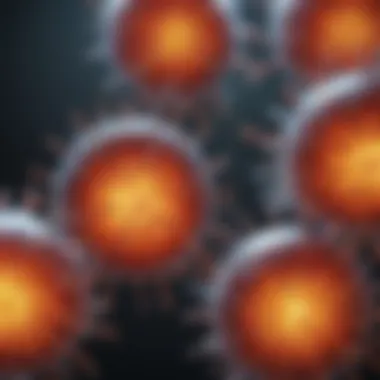
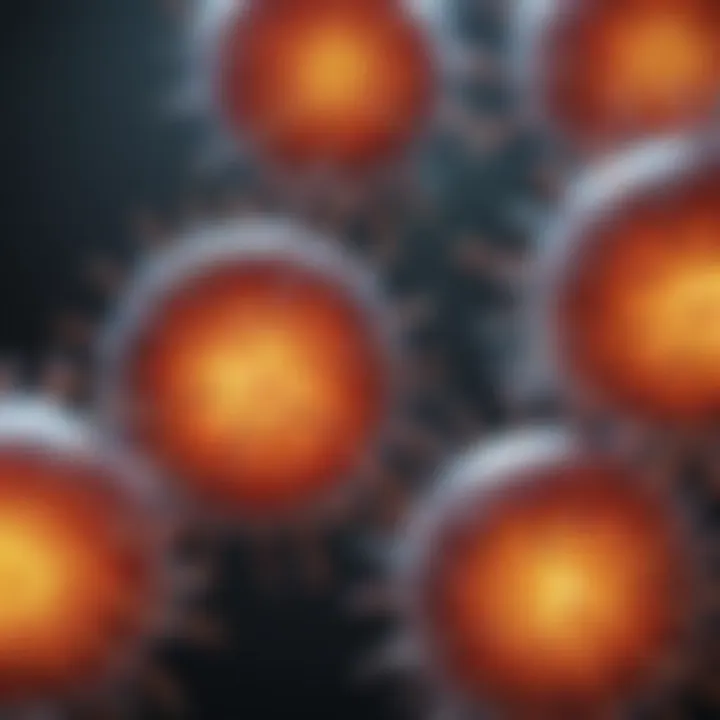
Intro
Getting into the nitty-gritty world of cellular biology often feels like peeling an onion. Each layer reveals something more complex and intriguing than the last. Among these layers, clathrin and its antibodies hold a significant place. These components are a crucial part of many cellular processes, especially in vesicle formation and endocytosis, which are the talk of the town in scientific circles.
Clathrin is like the scaffolding of a cell, forming structures that are essential for transporting materials within the cell. But it's not just clathrin that's got the spotlight; its antibodies are equally important. They help in understanding how these processes work, allowing researchers to manipulate and observe functions at a molecular level. So, let’s delve into the importance and significance of clathrin antibodies in cellular mechanisms.
Prelims to Clathrin and Its Role in Cells
To understand the intricate machinery of the cell, one must take a closer look at the various components that make up this lively environment. Among these, clathrin stands out as a pivotal protein that carries significant responsibilities in cellular dynamics. This section will peel back the layers surrounding clathrin’s molecular structure and its place in cellular mechanisms, acting as the foundation of subsequent discussions regarding clathrin antibodies.
Initially, it’s essential to grasp what clathrin is. Think of it this way: clathrin is like the scaffolding of a building, the framework that supports a host of vital processes. Its role in forming vesicles is crucial during endocytosis—where cells engulf external substances to incorporate them internally. Without efficient clathrin function, cellular communication can falter, ultimately affecting organismal homeostasis.
Molecular Composition of Clathrin
Clathrin molecules consist of three heavy chains and three light chains, forming a structure reminiscent of a triskelion or a three-legged stool. When clathrin assembles, it forms a basket-like shape around the membrane invagination. This structure is not just for show; it’s fundamentally practical. Once clathrin assembles into this unique shape, it triggers a series of events. This includes recruiting additional proteins that facilitate the budding off of vesicles from the membrane.
Additionally, the specificity of clathrin’s interactions plays a critical role in guiding the uptake of particular molecules. Consider it like a bouncer—clathrin decides who gets in and who stays out, thereby regulating essential intracellular pathways.
Functions of Clathrin in Cellular Mechanisms
Clathrin is not a one-trick pony. Its roles are multifaceted:
- Endocytosis: Clathrin-dependent endocytosis is the most well-known function. Here, the clathrin coat forms around the vesicle, assisting in the internalization of various molecules.
- Signal Transduction: Clathrin is involved in the internalization of receptors, thereby influencing signaling pathways that dictate a cell's response to external stimuli.
- Intracellular Trafficking: Once the vesicles are formed, clathrin helps direct these cargoes to their appropriate destinations in the cell or to be sent out again.
In summary, clathrin plays a critical role in maintaining the balance within cells. Without its structure and function, the myriad cellular processes that define life could falter.
"To every action, there is always an equal and opposite reaction; in cells, clathrin ensures that actions do not go unnoticed and are efficiently managed."
As we move forward in this exploration, understanding clathrin will provide context to its antibodies and the broader implications for cellular health and disease.
Understanding Clathrin Antibodies
Understanding clathrin antibodies is essential for grasping how these specific proteins function in cellular mechanisms. Clathrin antibodies serve as vital tools in researching various processes surrounding vesicle formation and intracellular trafficking. Their significance lies not only in identifying clathrin proteins themselves but also in leveraging this knowledge to explicate broader biological phenomena, such as nutrient uptake and signal transduction.
What Are Clathrin Antibodies?
Clathrin antibodies are specific types of antibodies crafted to recognize and bind to clathrin molecules, which play a crucial role in the endocytosis process. Formulating these antibodies usually involves the immunization of animals, such as rabbits or mice, leading to the generation of an immune response that produces these antibodies. The clathrin molecules targeted can be from different types of cells, making clathrin antibodies useful across a range of biological fields.
The importance of clathrin antibodies extends into various research and diagnostic applications. For instance, they can be used to track clathrin distribution within cells. This tracking is essential for understanding not just normal cellular functions but also alterations in disease states. By delving into how clathrin antibodies operate, researchers can unveil critical insights about cell behavior and interactions in health and disease.
Types of Clathrin Antibodies
Clathrin antibodies come in several varieties, each tailored for different research purposes. Among the most notable types are:
- Monoclonal Antibodies: These are produced from a single clone of cells and can provide high specificity against clathrin proteins. Researchers often prefer them for experiments requiring precise measurements or localization.
- Polyclonal Antibodies: These are derived from multiple B cell lineages and may recognize different epitopes on clathrin molecules. While they may have less specificity, they can be advantageous in identifying various forms of clathrin in different cellular contexts.
- Recombinant Antibodies: These are engineered antibodies using recombinant DNA technology. They typically offer high specificity and can be produced in large quantities, making them useful in assays and therapeutic applications.
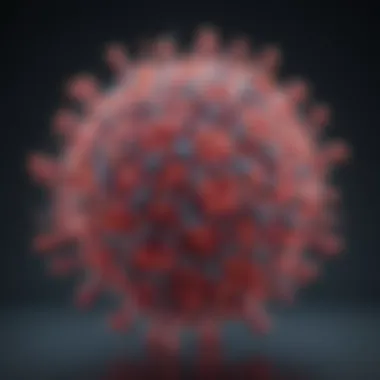
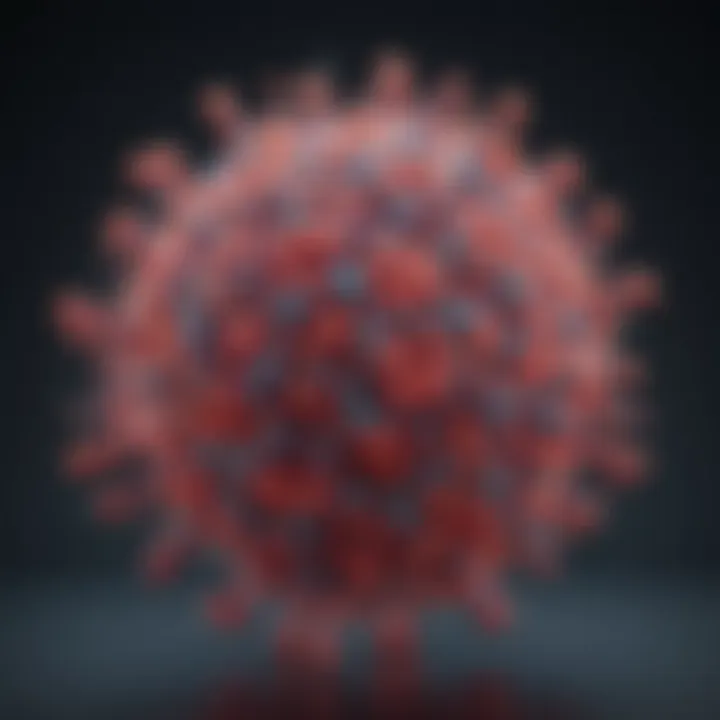
The choice between these types often depends on the specific requirements of the study at hand, such as the need for specificity, sensitivity, or large-scale production. Ultimately, understanding the various types of clathrin antibodies helps researchers select the most appropriate tools for their investigations.
"Clathrin antibodies not only illuminate cellular pathways but also bridge the gap between basic research and clinical applications."
In summary, clathrin antibodies represent an important angle in the exploration of cellular mechanisms. Their specificity and adaptability lend much-needed insight into the roles of clathrin in cell dynamics, enriching our overall understanding of various biological processes.
Mechanisms of Clathrin-Mediated Endocytosis
The mechanisms through which clathrin mediates endocytosis are not just fascinating; they are crucial for understanding how cells communicate and interact with their environment. Endocytosis allows cells to engulf extracellular substances, thus maintaining homeostasis and facilitating various cellular responses. The clathrin-mediated pathway is particularly significant due to its efficiency in transporting large molecules, which are essential in various physiological processes.
By grasping the intricate steps of clathrin-mediated endocytosis, researchers can appreciate how disruptions in this cycle can lead to diseases. When this process falters, various conditions, such as neurodegenerative disorders and cancer, can emerge. Thus, the study of these mechanisms sheds light on both normal physiological functioning and pathological conditions.
Beyond the medical implications, understanding clathrin's role in vesicle transportation offers insights into cellular development and intracellular trafficking. In this section, we delve deeper into two critical facets of clathrin-mediated endocytosis: the process of vesicle formation and the role of clathrin-associated proteins.
The Process of Vesicle Formation
Vesicle formation is indeed a complex yet fascinating process, where clathrin plays a starring role. The journey starts with the recruitment of clathrin to specific sites on the cell membrane. This recruitment is typically mediated by the activation of receptor proteins, which signal the need for endocytosis. Once in position, clathrin forms a basket-like structure that encapsulates the targeted area of the membrane.
- Initiation: The initial attachment of clathrin to the membrane marks the beginning of vesicle formation.
- Basket Formation: Clathrin molecules assemble into a polyhedral arrangement, resembling a cage, this structure is called a clathrin-coated pit.
- Membrane Invagination: The pit then invaginates, essentially folding inwards, which is essential for encasing the desired material.
- Vesicle Budding: As the invagination deepens, the vesicle begins to pinch off, eventually detaching from the membrane.
This entire process is not simply about clathrin; it involves a range of accessory proteins, known as adaptors, which facilitate the binding of clathrin to its cargo. The intricacy of this mechanism highlights how clathrin is not merely passive; instead, it actively orchestrates the transport of vital cellular components.
Role of Clathrin-Associated Proteins
Clathrin, by itself, does not carry out the entire endocytic process; its functionality is heavily reliant on its associated proteins. These proteins ensure that clathrin can efficiently encapsulate and transport various substances within the cell. Several significant players come into the fray here:
- Adaptor Proteins: These proteins connect the clathrin coat to the membrane and help select specific cargo that needs to be internalized. Common examples include AP2 and AP180, each playing their unique roles in cargo selection and membrane interaction.
- Dynamin: This GTPase is pivotal during the final separation of the vesicle from the membrane. It wraps around the neck of the forming vesicle, facilitating membrane fission.
- Clathrin Heavy and Light Chains: The heavy chains contribute to the structural stability of the clathrin basket, while light chains modulate the arrangement and recruitment of the clathrin coat.
"In the grand orchestra of cellular biology, clathrin-associated proteins are the conductors, ensuring precise performances."
The coordination among these proteins illustrates a well-oiled machine where timing and specificity matter. Disruption in the activities of these proteins can lead to significant impairments in cellular functions, further emphasizing their importance in clathrin-mediated endocytosis. Thus, advancements in understanding these interactions could potentially lead to groundbreaking treatments for related diseases.
In summary, the mechanisms of clathrin-mediated endocytosis reveal more than just cellular processes; they highlight the fundamental principles of biological organization and regulation. By exploring the dynamics involved in vesicle formation and the role of associated proteins, researchers can better appreciate the delicate balance of life at a cellular level.
Immunological Aspects of Clathrin Antibodies
Clathrin antibodies hold a crucial position in the realm of immunology as they interact with a fundamental process of cellular mechanisms. Understanding the immunological aspects involves unraveling how these antibodies are produced, their specificity, and the techniques used to detect them in various scenarios. This knowledge not only contributes to scientific research but also opens new avenues for therapeutic applications. It’s akin to peeling an onion where each layer reveals intricate details that push our grasp of cellular behavior forward.
Production of Clathrin Antibodies
The production of clathrin antibodies is primarily achieved through immunization techniques. Typically, researchers start by injecting suitable animal models, like rabbits or mice, with purified clathrin or clathrin-derived peptides. This triggers an immune response where the subjects' bodies generate antibodies against the clathrin antigens. It's a bit of a dance, where the immune system recognizes these proteins as foreign invaders and responds accordingly.
Some key points about the production of these antibodies include:
- Choice of Antigen: Selecting the right form of clathrin is essential; modifications and variants can impact immunogenicity.
- Adjuvants: Often, an adjuvant is used to boost the immune response. Adjuvants help increase the effectiveness of the vaccine by enhancing the body’s response to the antibody-producing antigens.
- Hybridoma Technology: This is another method used to produce monoclonal antibodies. By fusing myeloma cells with antibody-producing B-cells, researchers can produce a cell line that generates a specific clathrin antibody consistently.
In summary, producing clathrin antibodies demands careful planning and execution. It’s essential to select appropriate antigens and make choices that optimize the body's immune response.
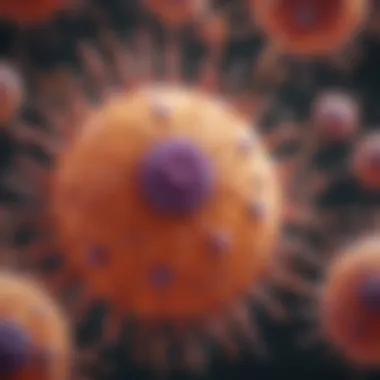
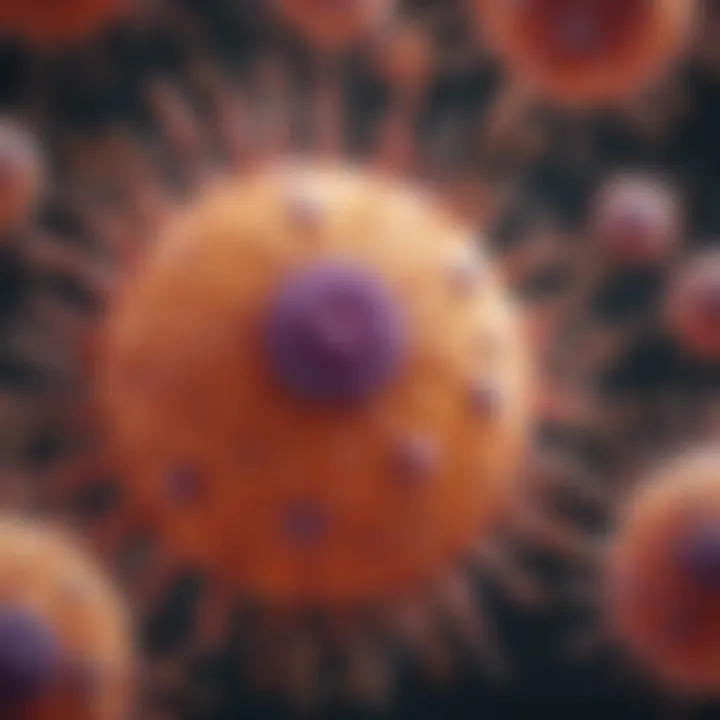
Detection Methods for Clathrin Antibodies
Once clathrin antibodies are produced, the next vital step is to detect and characterize them accurately. Several methods exist for this purpose, each with its own strengths and weaknesses. These can be broadly categorized into direct and indirect detection techniques.
- Western Blotting: A common method where proteins are separated by gel electrophoresis and then transferred to a membrane. The clathrin antibodies can then be visualized with specific secondary antibodies bound to detectable markers.
- ELISA (Enzyme-Linked Immunosorbent Assay): This technique allows for quantifying the concentration of antibodies in a sample. Clathrin is coated onto a plate, and samples are added to detect the presence of antibodies through a color change reaction.
- Immunofluorescence: Involves the use of fluorescently labeled antibodies to visualize clathrin in cells. This method is powerful for assessing the localization and dynamics of clathrin within cellular structures.
Detection methods not only reveal the presence of clathrin antibodies but also provide insights into their functional roles in cellular processes.
Each of these techniques is pivotal in the ongoing exploration of clathrin's role in cellular mechanisms and helps establish their importance in various disease contexts. The knowledge gleaned from using these methods aids researchers in uncovering the complexities of cellular trafficking and endocytosis.
Applications of Clathrin Antibodies in Research
The exploration of clathrin antibodies provides valuable insights into cellular mechanisms and has paved the way for notable advancements in biological and medical research. Their utility extends across various domains, impacting how scientists examine cellular processes and investigate pathologies. By facilitating a deeper understanding of clathrin-mediated endocytosis, these antibodies help in elucidating the fundamental roles of clathrin in cellular functionality and signaling. This section delves into the specific tools available for research and their potential applications in the context of disease.
Tools for Investigating Cellular Processes
In the toolkit of researchers studying cellular behavior, clathrin antibodies serve as vital instruments. These antibodies can be utilized in numerous experimental settings to ascertain the presence, distribution, and dynamics of clathrin within cells.
- Immunofluorescence Microscopy: This technique employs fluorescently labeled clathrin antibodies to visualize clathrin-coated structures in live or fixed cells. It allows researchers to observe how clathrin is distributed across different cellular compartments, providing insights into endocytosis and vesicle trafficking.
- Western Blotting: This method helps confirm the expression levels of clathrin and its variants within cells. By using specific antibodies, scientists can detect and quantify clathrin in cell lysates, shedding light on the protein's role under various conditions.
- Flow Cytometry: Using clathrin antibodies in flow cytometric analyses can lead to the quantitative assessment of clathrin-rich vesicle populations within cell populations. This technique is operationally efficient and enables high-throughput analysis, catering to large data sets.
- Co-Immunoprecipitation: This approach allows researchers to investigate the interactions occurring between clathrin and other binding partners. By tagging clathrin with specific antibodies, scientists can isolate associated proteins, highlighting the complexities of protein networking.
These tools enable a multifaceted inquiry into cellular dynamics. Yet, acknowledging the limitations of each method is equally crucial. They demand precise optimization, and any missteps can lead to misinterpretation of data. Thus, combining techniques often offers a more robust understanding of cellular mechanisms.
Clathrin Antibodies in Disease Research
Beyond cellular investigations, the application of clathrin antibodies in disease research can’t be overstated. These antibodies have started to illuminate the pathophysiological mechanisms of various conditions, as clathrin plays a significant role in numerous cellular functions.
- Neurodegenerative Diseases: Researchers are exploring the impact of clathrin in diseases like Alzheimer's and Parkinson's. Abnormalities in clathrin's functioning could lead to the compromised endocytosis processes, potentially contributing to amyloid plaque formation or neuronal cell death.
- Cancer Research: Clathrin's role in vesicle trafficking can also influence tumor biology. By engaging with intracellular signals that dictate cell proliferation and migration, clathrin antibodies are essential for understanding how cancer cells might exploit these pathways for metastasis.
- Viral Infections: Clathrin is utilized by many viruses to enter host cells. Investigating these interactions with clathrin antibodies can provide insights into viral life cycles and raise possibilities for therapeutic interventions.
"Utilizing clathrin antibodies can be a game-changer in elucidating the roles of endocytosis in various diseases, making them key players in research endeavors across multiple domains."
In summary, the applications of clathrin antibodies in research underscore their versatility and importance in advancing scientific understanding. These antibodies foster both foundational and applied questions in biology, making them indispensable in ongoing research evolution.
Challenges in Clathrin Antibody Research
The exploration of clathrin antibodies presents several challenges that can hinder scientific advancement in understanding cellular mechanisms. Addressing these challenges is crucial as they not only influence the quality of research outputs but also affect the broader scientific community's understanding of clathrin's role in various cellular processes. The complexities associated with clathrin antibodies boil down to specificity and the limitations inherent in current experimental designs.
Specificity Issues in Antibody Development
One of the most pressing concerns in clathrin antibody research is achieving specificity in antibody development. It’s not uncommon for antibodies to cross-react with other proteins, leading to ambiguous results. These unwanted bindings can muddle interpretations and create a significant hurdle when one tries to link observed phenomena to clathrin functions.
Key elements contributing to specificity issues include:
- Antigen Similarity: Clathrin shares structural similarities with other proteins. This resemblance can entice antibodies to bind non-specifically, thus obscuring experiments.
- Host Immune Response Variability: Different organisms may produce antibodies that exhibit varying degrees of affinity for clathrin. This inconsistency makes it hard to predict outcomes when translating findings across species.
Additionally, the evolution of methods such as phage display and hybridoma technology has aimed to improve specificity. Nonetheless, these endeavors sometimes fall short, leading to cross-reactivity that complicates data interpretation. The repercussions of these specificity issues further amplify when applied in pathological contexts.
Limitations in Experimental Design
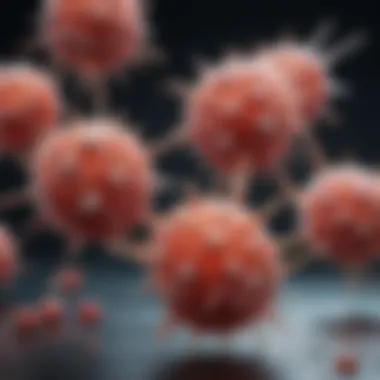
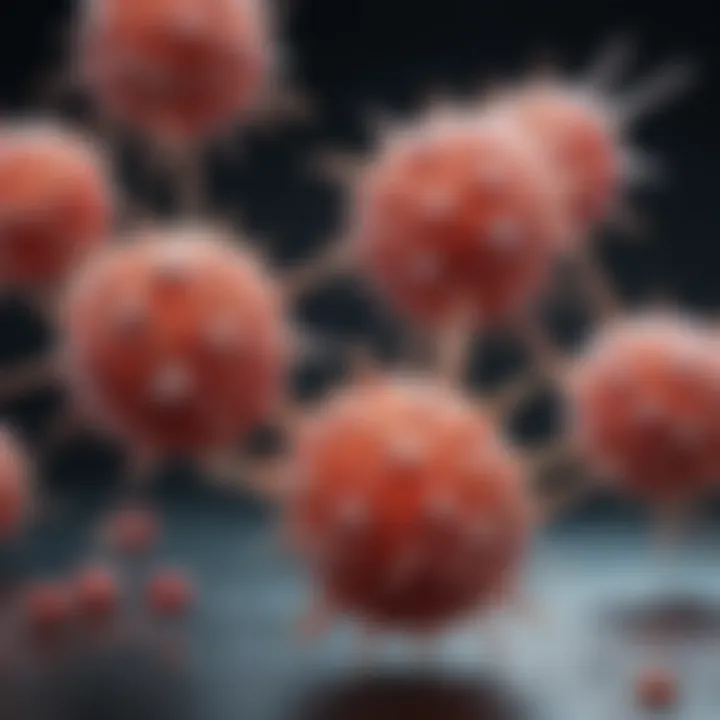
Experimental design in clathrin antibody research poses its own set of limitations, often restricting the scope and reliability of findings. Some common pitfalls include:
- Underutilized Controls: Inadequate use of proper controls can waterfall into misunderstood interpretations. Without stringent controls, the role of clathrin antibodies can become overemphasized or misrepresented.
- Lack of Standardization: Variability in antibody preparation and testing methods across different labs can lead to inconsistent results. Such discrepancies squander the ability of researchers to build upon each other's findings, resulting in a fragmented understanding of clathrin’s biological roles.
To mitigate these obstacles, it’s imperative for researchers to adopt robust methodologies and standardized protocols. Collaborations among laboratories can also foster enhanced reproducibility and precision in results, paving the way for a clearer narrative regarding clathrin's function.
"The intricacies of developing clathrin antibodies cannot be underestimated; they are the bedrock on which our understanding of cellular dynamics is built."
In summary, challenges in clathrin antibody research not only affect the outcomes of individual studies but also have far-reaching implications for the overall scientific discourse. Addressing these challenges head-on is essential for fostering clearer insights into the fascinating world of cellular mechanisms.
Future Directions in Clathrin Antibody Studies
As the field of cell biology advances, particularly in the realm of clathrin antibodies, the importance of future research directions cannot be overstated. The study of clathrin and its associated proteins has opened a Pandora's box of potential breakthroughs. Clathrin antibodies are not just tools for understanding cellular mechanisms; they stand at the precipice of revolutionizing approaches to disease treatment and diagnosis.
Innovations in Clathrin Research Techniques
Innovation is the lifeblood of scientific advancement. Recent years have seen a slew of new techniques emerging that promise to enhance our understanding of clathrin-mediated processes. For instance, advances in imaging technologies, like super-resolution microscopy, allow researchers to visualize clathrin dynamics in real-time at the molecular level.
Moreover, techniques such as CRISPR-Cas9 gene editing are being employed to create knockout models that help to elucidate the specific roles of clathrin and associated proteins. This genetic manipulation can assist in creating more targeted therapies, making the interplay between various cellular mechanisms clearer.
An additional promising technique is the application of mass spectrometry in identifying antibody-binding sites on clathrin. This precision not only advances our basic understanding of clathrin but could also lead to personalized medicine approaches based on individual cellular responses. Consider these innovations:
- Super-resolution microscopy for observing clathrin behavior in living cells.
- CRISPR-Cas9 for generating specific gene knockouts to study metabolic pathways.
- Mass spectrometry for understanding the interactions between clathrin antibodies and their targets.
Each of these methods chips away at the complexities surrounding cellular interactions, propelling the field forward.
Potential Therapeutic Applications of Clathrin Antibodies
The therapeutic potential of clathrin antibodies remains both exciting and multifaceted. One could argue that their applications are akin to those of a Swiss Army knife—versatile, effective, and indispensable. As research continues to unfold, several key areas stand out:
- Cancer Therapy: Clathrin antibodies have shown promise in selectively targeting cancerous cells. By inhibiting clathrin-mediated endocytosis in tumor cells, it's possible to disrupt their nutrient uptake, thereby stunting growth.
- Neurodegenerative Diseases: Recent laborartory studies have highlighted that clathrin is involved in the transport of important neurotrophic factors. Antibodies targeting clathrin could offer pathways to enhance neuron health and combat disorders like Alzheimer's.
- Viral Infections: Clathrin facilitates the entry of various viruses into host cells. These antibodies may block viral entry, serving as a foundational step for developing new antiviral therapies.
- Immunotherapy: By leveraging clathrin antibodies in immunotherapy, researchers can innovate ways to activate immune cells, prompting more effective responses against foreign invaders.
"The revolutionary potential of clathrin antibodies may well change the landscape of modern therapeutics, offering hope where previously there was none."
End
In the realm of cellular biology, understanding the role of clathrin antibodies offers critical insights into cellular mechanisms and processes. This discussion has shed light on the multifaceted nature of clathrin and its antibodies, revealing their significance in vital physiological functions like vesicle formation and endocytosis. The intricate details presented throughout the article emphasize that clathrin antibodies are more than just research tools; they are pivotal assets in deciphering complex cellular dynamics.
Summarizing Key Findings
To encapsulate the crux of our investigation:
- Clathrin's Molecular Role: Clathrin's distinctive structure is crucial in vesicle formation during endocytosis. Its ability to form triskelion shapes harnesses the energy necessary for membrane invagination.
- Diverse Antibody Applications: Clathrin antibodies facilitate diverse applications in research, from probing intracellular trafficking to investigating pathologies like cancer, where cellular uptake mechanisms are often hijacked.
- Immunological Aspects: The production and detection of clathrin antibodies are pivotal in advancing our understanding of clathrin's role in health and disease, underscoring the intersection of immunology and cell biology.
This multifaceted exploration not only unveils the operational intricacies of clathrin and its antibodies but also demonstrates their critical relevance in various research domains and diseases.
Encouraging Continued Exploration
The examination of clathrin antibodies does not end here; it beckons continued vigor in research and exploration. As science advances, several pathways remain ripe for investigation:
- Innovative Detection Techniques: The evolution of more refined detection methods for clathrin antibodies can enhance the specificity and sensitivity in studying dynamic cellular events.
- Therapeutic Potential: The potential therapeutic applications of clathrin antibodies in modulating cellular responses in disease contexts warrant deeper examination. Research could lead to novel interventions aimed at correcting aberrations in cellular trafficking.
- Collaborative Research Efforts: Encouraging collaborative efforts between immunologists and cell biologists could yield new insights and innovative approaches to tackling complex biological problems.
As the scientific community continues to probe these avenues, the prospects for understanding clathrin antibodies' role in cellular mechanisms become wider and more exciting. This article serves not just as a summary but as a call to arms for researchers and practitioners alike to dive into the depths of clathrin research, driving forward knowledge that could change the landscape of cell biology.



